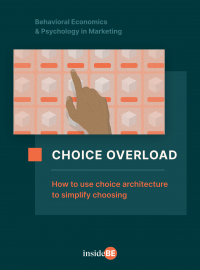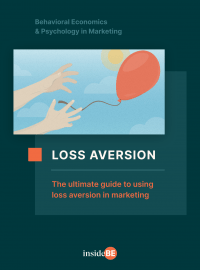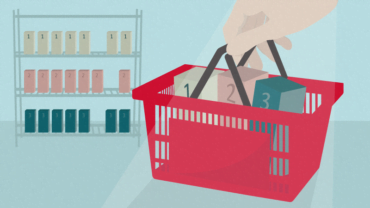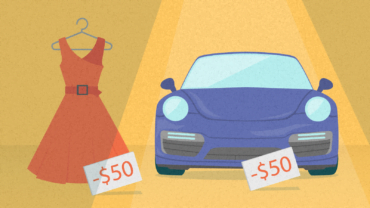Simon Moore: Don’t Shout Price at Me! Never in 20 Years Have I Seen That to Be the Deciding Factor
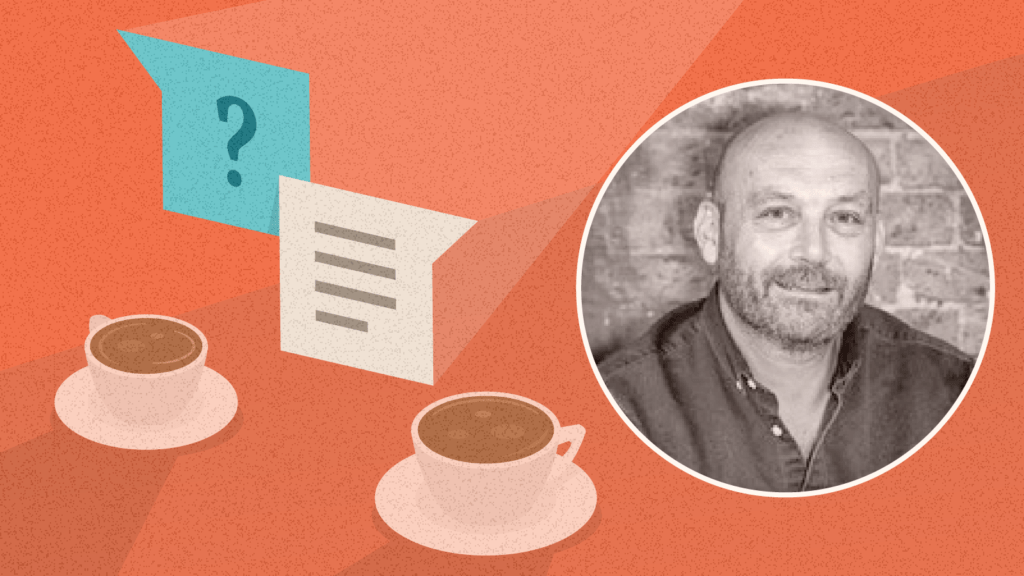
Dr Simon Moore, the founder of Innovationbubble, shares some surprising insights on how we choose insurance and holidays, how to get to what your customers need, and makes a case that sometimes a really small step change can create a really big effect.
In this interview, you’ll learn:
- What 4 basic needs groups customers fall into and how to speak to them;
- How we buy glasses and choose friends and what businesses can learn from that;
- Why it is better to rely on images instead of questions in customer research;
- Why going frictionless is not always the best idea; and
- Why sometimes people are happier to tick the things they don’t want in their vacation plan than the things they do.
How does one go from working on survival and conservation with dolphins and apes to founding a company which helps companies understand their customers and employees?
I was lucky enough to get involved in animal research from a conservation point of view quite early on. When I was still an undergraduate, I did a voluntary year at a zoo. And I saw that understanding humans was just as applicable as understanding behavioral patterns in animals.
It turns out a lot of things I did at the zoo in terms of branding and positioning were applicable for other businesses. The rest was a combination of luck and my frustration with academia. But many people thought I was having a nervous breakdown when I decided to leave university and put together my own company (smiles).
Do you see any parallels between how humans vs. dolphins and apes behave?
Definitely! Humans give themselves too much credit. We like to think we’re miles away from animals, but lots of our behavior is auto-governed.
In fact, about 80% of what you do, you have no idea why you do it, and that’s If I’m being kind. If I was being unkind, I would say you’re in control of about 5% of what you do. And this really intrigues me as a psychologist.
In fact, I would say you’re in control of about 5% of what you do.
The fact is that we make very quick, non-conscious, emotional assessments all the time! I know people say “no I don’t”, but as soon as a new person enters a room, you’re quickly assessing what they could mean to you. Are they a threat or someone I might like? You might even think “Oh my God, they’ve got orange trousers on, they must be a lunatic, I’m gonna keep my distance”. And all that elaborate calculation happens in a split second.

Discover ground-breaking ideas and fascinating solutions.
How does that inform our decisions as customers?
I like to give an example of how we choose friends. We don’t choose them based on how much hair they have (I’d fall short in that department), how good their skin is or how much money they make.
Those are all pragmatic things. What makes a friend is based on how they make us feel; some friends are funny, some are supportive, some are intellectual, they help us meet certain needs.
If I as a brand make you feel comfortable, or that something is relevant to you, then you will pay attention to price and quality.
Choice Overload
Choice overload is a result of too many choices being available. It can result in decision fatigue, sticking to the default option, or even avoiding making a decision altogether.
But when you look at companies, they’re so pragmatically oriented: it’s about quality and price, when in fact, they need to think more about that emotional relationship – how they make consumers feel. If I as a brand make you feel comfortable, or that something is relevant to you, then you will pay attention to price and quality.
But if I have 16 brands shouting prices at me, that’s quite stressful; I’m going to get confused and bail out. I just wanted to buy a pair of jeans and now I have 16 prices to remember and what the cheapest one is. That’s too much work.
More and more businesses are getting familiar with behavioral biases (social proof, scarcity, etc.) and how these can be used to influence behavior. But you talk about needs, and your company Innovationbubble also seems to put them front and center. What’s the relation between the two?
Addressing behavioral biases can work and be effective. But I personally think we need to go deeper than that; if I can work out what you need on an emotional level, I can be more precise in what interventions to use.
So if you can slot the two together (the underlying psychology and behavioral principles) it becomes quite powerful, because now you know which interventions will work better with which group.
And what’s quite neat is that we can divide people who live anywhere across the globe into four basic need groups.
Can you share more about each group and what needs they have?
Loss Aversion
We are roughly 2.5 times more sensitive to losses than we are to gains of similar size. A message framed as a potential loss might therefore be more persuasive.
There are planners who are anxiety-driven; those are the people who before going to a party need to know where the party’s at, who is going, what those people will be wearing, what times it gets really busy, etc. They need transparency about information and control. So risk (alleviating uncertainty – editor’s note) and loss aversion are going to be really powerful principles to use in any communication because for them it’s really about managing risk. They need immediate reassurance which prevents them from anxiety.
But if you take an adventurer, someone who has a high need for innovation and new experiences, loss aversion won’t work as well. They are quite risk-tolerant, in fact, they need some level of risk to get to where they want to go.
The third group are the sociables who have a high need for social inclusion. The worst thing for them is to get ostracized from groups. They are slightly anxiety-driven, because they want to know what the rest of the group want; customer reviews work for them quite nicely.
Social Proof
Social proof is our tendency to be influenced by what others do, how they think and behave. Social proof works particularly well in situations of uncertainty.
And finally, individualists are similar to adventurers, meaning they are not so bothered about risk, but for them, it’s more about ego and status. They want to stand out, become a leader. Individualists need to feel smart about their choices.
Banks often say “be smart with your money, choose us”. But the people who have made a lot of money like to think they made it, not you (the bank), so you’re actually undermining their need for fulfillment! If I choose you and you say you’re a smart insurance company, you’re taking smartness away from me.
A lot of brands get that positioning slightly off because they too have egos. But when communicating with individualists it’s fine to internally say “we are smart”, but externally frame it as “we are here to make you smart” That can get them more engagement.
it’s fine to internally say “we are smart”, but externally frame it as “we are here to make you smart”
That sounds intriguing but some may argue that the four type model might be a little simplistic. Are we only governed by a single need?
No. These are not mutually exclusive; every human has elements of those. But the difference is the volume in which these are present. If you’re a planner, you’re more guided by those needs, but sometimes the planning needs will kick in as well.
Going back to your insurance example. How do you sell insurance to a planner? I guess it would be different from an adventurer…
Yes. The difference is in framing and positioning.
For an adventurer it would be answering the question: how does your service support them getting where they want to get to? You frame it as giving them wings, enabling them to go off and carry on doing all the funky things they want to do because they know, at the back of their mind, you’re there to help them out.
Whereas with a planner, you want to safeguard them against loss. You are buffering them against their anxiety. They want to know: “have you got all my risk locked down before I can go on with my life in general?”.
One mistake that companies make is that they always sell the positives. We think people want an immediate reward, or immediate feedback for their actions.
But especially with planners, don’t lead with positives. First, you need to remove all their risk questions. Things like: Is the policy going to go up? Do I need to invest a lot of time in form-filling? How many people have claimed it before? How successful is that?
So why do companies still sell the positives first and foremost?
Because most of them think: “Oh no, we can’t talk about risk (touch on people’s uncertainties – editor’s note) because that will worry people!” When in fact the opposite is true. It will actually reassure a lot of people. Because they want to know that you as a company have thought about and addressed risk as well.
If you do that, customers go: “Oh great, you’ve thought about risk, I’m comfortable. Now tell me what the benefits are”.
At the moment we’re working on a merger with an insurance company; they are trying to keep as many customers as they can. We help them identify the needs of the current customer base, which will then inform how we write the letters, and communicate on the website, so that the merger feels more like an opportunity rather than a risk. Because as you can probably guess planners will be freaking out. (laughs)
I can see how getting to the why behind the buy is very important. But even if a company does customer research, getting to the why might be tricky. So how do you discover those needs?
First thing, don’t put answers right in front of the customer – they will just say yes. One of the worst questions to ask is: “if we did this, would you like it?”.
One of the worst questions to ask is: “if we did this, would you like it?”
Most people say yes. And that’s human. If I say I’m going to give you a free pencil, an orange, and a bar of chocolate, would you say no? It might not be relevant to you, but it’s no skin off your nose, you’re not investing any money or time, I’m doing that.
Can you ask different questions?
Yes, but we need to look beyond what people are saying; we try to get to the non-conscious part of the brain. Initially, we don’t ask questions, we use lots of images and scenarios and listen to what people are responding to. We see certain themes emerge which explain why customers would or wouldn’t engage.
And that gives us clues about follow-up questions, which we put into an online test that takes about 5 minutes. It helps us identify with 90% statistical probability, what are the top things that are influencing any given decision.
So the psychology part is the investigative part which does the heavy lifting and informs your campaign and strategies. And if you then give it to the behavioral science people, they will do fantastic things with it!
That’s because they are now working with a higher level of probability that certain solutions will work because the psychologists have done their homework.
Who do you usually work with on the client’s side? Why do they seek you out?
We work a lot with marketing, sales, and digital in the customer space. I think there’s a growing frustration that what they’ve been doing has not been enough. These people often have no real clue about what their customers need.
But if you have the insights, you then know how to message or create a website which has better engagement. In a B2B space, we also train salespeople to identify who is in front of them, an adventurer or a planner…
Are there any common misconceptions that you see repeated over and over again among business executives or sales teams?
One, is that they think data is their friend. They just buy big data; that’s meant to solve everything! But if you ask them, they’ll say it’s the worst thing that they did. They spent a lot of money and now they’ve just got more questions, no answers and a headache. Because with big data you are no nearer to knowing why someone is buying your jeans rather than anyone else’s.
The other thing is price. Everyone shouts price at me! I have never ever been involved in a project in twenty years where price has been the leading thing that’s made customers choose a specific brand over everyone else to start with. Why would people buy more expensive stuff if it was just about the price?
Price might come into it later on, but it’s pragmatic. Let’s think about the difference between pragmatic and emotional when it comes to buying glasses. The pragmatic reason to buy a pair of glasses is to see better. But if that was the only reason, we would only need one universal pair of glasses.
I have never ever been involved in a project in twenty years where price has been the leading thing that’s made customers choose a specific brand over everyone else to start with. Why would people buy more expensive stuff if it was just about the price?
But it’s the frame that sells more than the actual lenses. Emotionally, you don’t want to look stupid, you want to stand out or fit in…This also explains why people who should be wearing glasses don’t have any. So I could sell you a pair of glasses really cheaply, but if you emotionally think glasses are not for you because they make you look stupid, it doesn’t matter – you won’t buy them.
There is a movement in customer space towards reducing friction. But you claim to hate the word frictionless. Why?
Because making everything really easy for customers is really dangerous. There’s more value in things we put more effort into. If you make it too easy for me to buy stuff, it’s really easy for me to leave as well. I’ve got nothing invested in you!
Take companies that give loans or mortgages – if you do it too quickly that undermines people’s feeling that you are doing it properly. They wonder: “how can you give me a loan in 4 minutes? I’m not sure this is even legit.” Whereas if they say: “we will get back to you in three hours”, you’d think they are obviously doing their homework.
Friction
Everything along the customer’s journey, which is objectively a little harder than it should be. it needs to be removed to elicit a desired behavior or response.
I’m not saying frictionless isn’t useful. For example, take how we choose holidays. Research suggests that when people are having a bad day at work, they will go on to travel sites and have a look at where they could go. Not really intending to buy, but as a sort of daydreaming.
But if you suddenly land on a page which tells you, you have 30 seconds to make a choice; it’s frictionless, but you go ”Whoa, I just wanted to look around!”
So don’t make it quick for me to look, but once I’ve decided what I want, then make it easy and painless to buy it. The purchase is one thing you always want to make frictionless! But if you make everything quick, half of the fun of looking at holidays – plotting and planning about what you would do there – is gone.
There’s more value in things we put more effort into. If you make it too easy for me to buy stuff, it’s really easy for me to leave as well.
So based on that, how would you advise a travel agency to structure its webpage?
We’ve actually done this with a couple of agencies. The first thing is to identify who you are talking to. Immediately after arriving at the webpage, we ask people to click through a few images, which tell us to which of the four groups they belong. We then cut down the choice for them.
But even if you’re trying to figure this stuff out on your own, you can rethink how you work with affirmation. Notice how you can always tick the things you want: the beach, the pool, the rooftop bar…
But for planners with their risk aversion and anxiety this might not be the most soothing feature. They go: “I don’t like sand and I don’t like children. Can I click “I don’t want those things”?” If they can only click the things they want, they’re still not going to be assured this will help them avoid children and sand.
So there are little tricks you can use if you know who the audience is. And you might then realize that sometimes people are happier ticking the things they don’t want, because it offers that reassurance.

